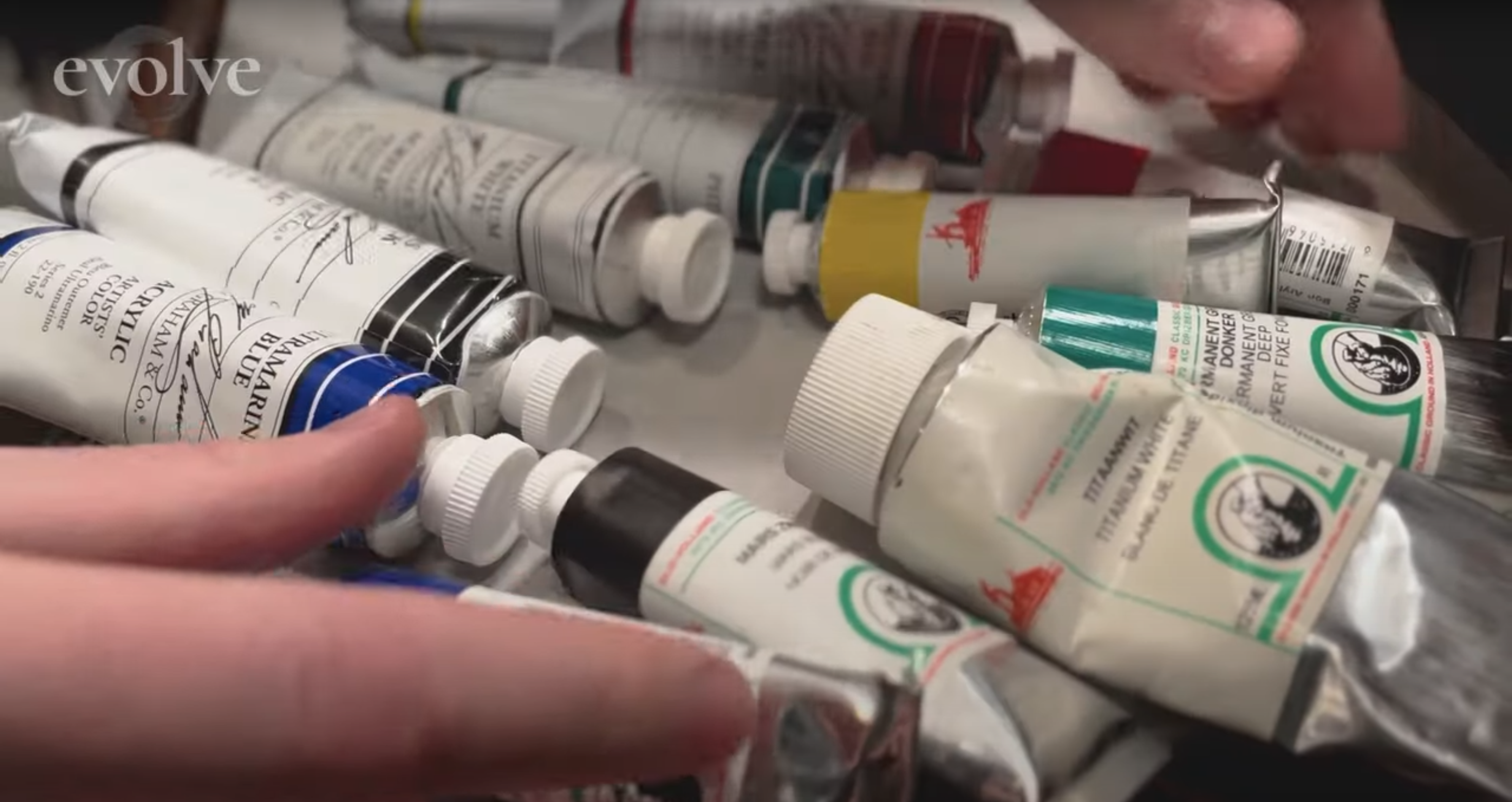
Daniel Folta of Evolve Artist will perform a gradient test to compare acrylic vs oil paints.
Which is Better for Learning Art: Acrylic vs Oil Paint?
This may be controversial, but at Evolve Artist we believe that if you want to learn how to paint, you should start with oils. I will be making the case for why oil paint is better for learning than acrylic. We’ll discuss the differences between these paints, see some side-by-side comparisons, and address some common objections.
The Fastest Way to Learn How to Paint

The fastest way to learn is to perfect one skill at a time.
In the Evolve program, we can get our students to pro-level painting skills in about 350 hours, which is a really short amount of time. However, I’m not confident that we would be able to do that in the same amount of time if we taught in acrylic instead of oil.
The fastest way to learn how to paint and many other skills, for that matter, is to perfect one simple skill at a time, starting with the most important foundational skills first, so that each skill builds directly on top of one another so that each new skill is supported by all of the skills that came before it.
Because you’re carefully investing your time into perfecting one skill at a time, it might seem slower than other methods at first, but if your goal is pro-level art skills, you will quickly surpass all the other methods by a long shot. So let’s keep this in mind as we break down the differences between these paints.
Acrylic Dries Fast: Good or Bad?
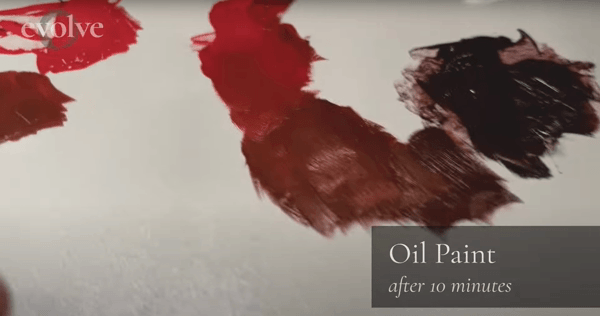
After 10 minutes, the acrylic paint has completely dried, compared with the oil paint which is still wet.
The most obvious difference in acrylic vs oil paint is the drying time. Acrylic dries fast, and this is a big disadvantage for learning. When you’re painting with acrylic, you have to be constantly aware of how wet or dry the paint is.
It’s even worse that the composition of the paint is firming up and changing while you are still painting, making it incredibly difficult to manage with a brush. This adds an additional dimension of complexity when you’re learning the most basic of skills, and this gets in the way of perfecting one simple skill at a time. Acrylic paint compels you to work fast.
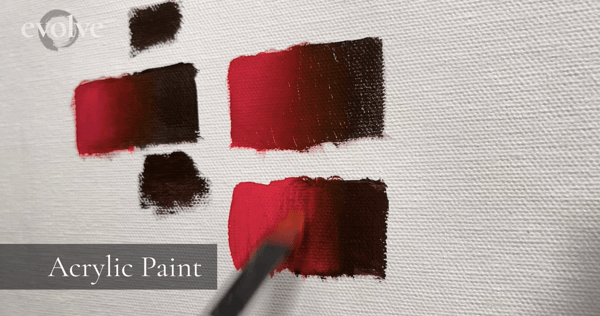
Acrylic paint dries while you are still painting, compelling you to work fast, which causes you to rush your learning.
When you are learning, speed is your enemy. Having a clock ticking in the background adds another level of pressure, forcing you to rush your painting to get everything in before the paint dries.
Rushing prevents you from perfecting those basic but vital skills and will develop bad habits, not allowing you to move forward with your art. To avoid rushing with acrylic, you could paint in layers, but that doesn’t make the drying time go away. Moreover, it adds more steps to a process that we want to keep simple for learning. The fewer skills that you need to develop to reach mastery, the quicker you’ll get there.
Acrylic vs Oil Paint: Which Paint is More Forgiving?
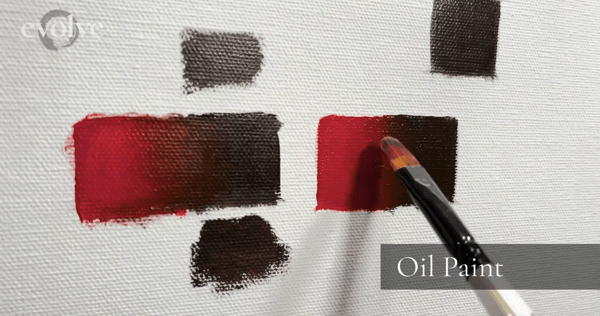
Oil paint gives you the time to complete your painting because of its slow drying time.
In comparison, oil paint gives you the time to complete whatever you intend to do with a brush. You can easily wipe parts out of the painting, put them back in, and push and pull the paint around to get the effect that you want.
Oil paint is much more forgiving than acrylic (and especially watercolor). When you’re learning, you want to work with a paint that doesn’t severely punish you for your mistakes.

Acrylic dries while you are still painting.
When you’re learning, you want to have the chance to do your absolute best and put the brush down on your own terms, on your own time, and be able to say, “I have painted this to the absolute best of my ability,” rather than work with a paint that dries faster than you can even paint it.
Can You Adjust Drying Times?
Now, you can adjust the drawing times for both acrylic and oil paints. With oil, you can quicken or slow down the drying time and even make a painting dry overnight as long as you aren’t using heavy impastos. You can also lengthen the dry times of acrylics, but at that point, you may as well be using oils with their superior quality and other advantages, such as how easy it is to mix oil paints together.
Mixing Paint With Acrylic vs Oil Paint
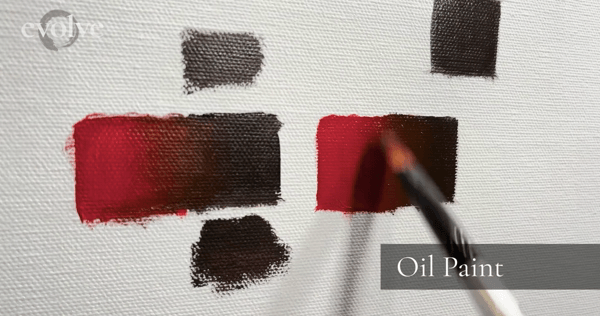
Oil paint (right rectangle) naturally blends more easily than acrylic paint (left rectangle) does.
Let me put it this way: ff you look online, you’ll find people searching for how to blend acrylics like oils, but you’ll never find someone searching for how to blend oils like acrylics.
Why Gradients Are Important
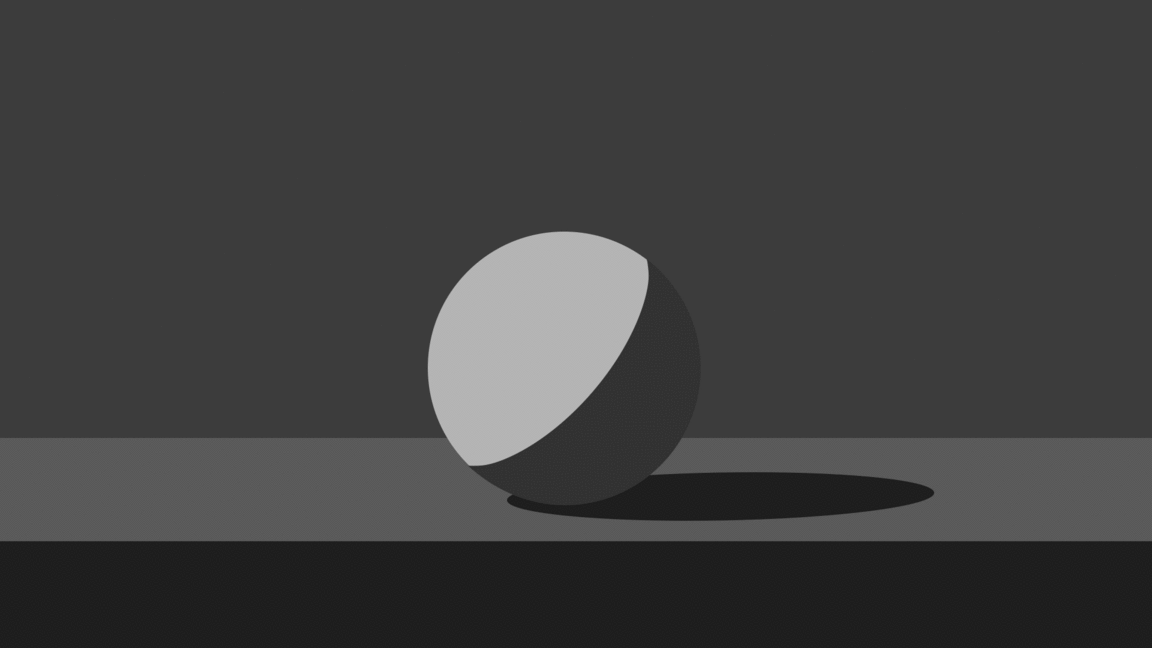
Gradients are essential in creating a life-like impression of the objects you are painting.
One of the first things that you need to learn in painting is how to make a gradient. Look at how this sphere isn’t complete without one. In order to turn form to give a life-like impression of three dimensions and volume, you need to learn how to make a gradient.
Learning how to paint a gradient is essential because our world is made up of all kinds of transitions (gradients) from one thing to another. Your ability to make a gradient is one of the most simple, objective ways to verify whether or not you have command over your brush. It’s incredibly important to learn this from the very beginning to accelerate your growth as a painter.
Acrylic vs Oil Paint: Which Paint Blends More Easily?
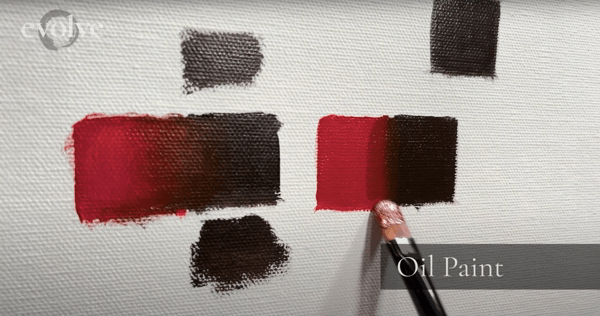
Oil paint blends with itself more easily than acrylic paint does.
Oil paint mixes and blends with itself easily. This is essential in order to make the smoothest gradients far beyond what any other paint can offer you. We want your learning journey to be as smooth and frictionless as possible. Don’t make what is arguably the most challenging beginner skill even harder by trying to do it with acrylic.
The Gradient Test
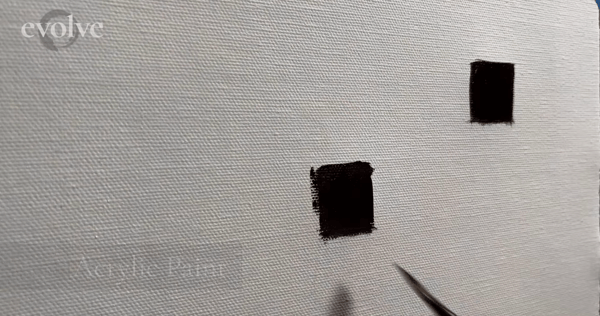
A gradient test shows a side-by-side comparison of how oil paint blends more smoothly with itself than acrylic paint does.
I want to let the paint speak for itself, so I ran a highly controlled gradient test (See the full methodology and results HERE). I set up the test in such a way that would show any subtle blemishes in my brushwork as I tried to make the smoothest gradient possible. Despite using a highly respectable acrylic paint, after three attempts, I couldn’t come close to the level of softness that I was able to easily achieve with the oil paint.
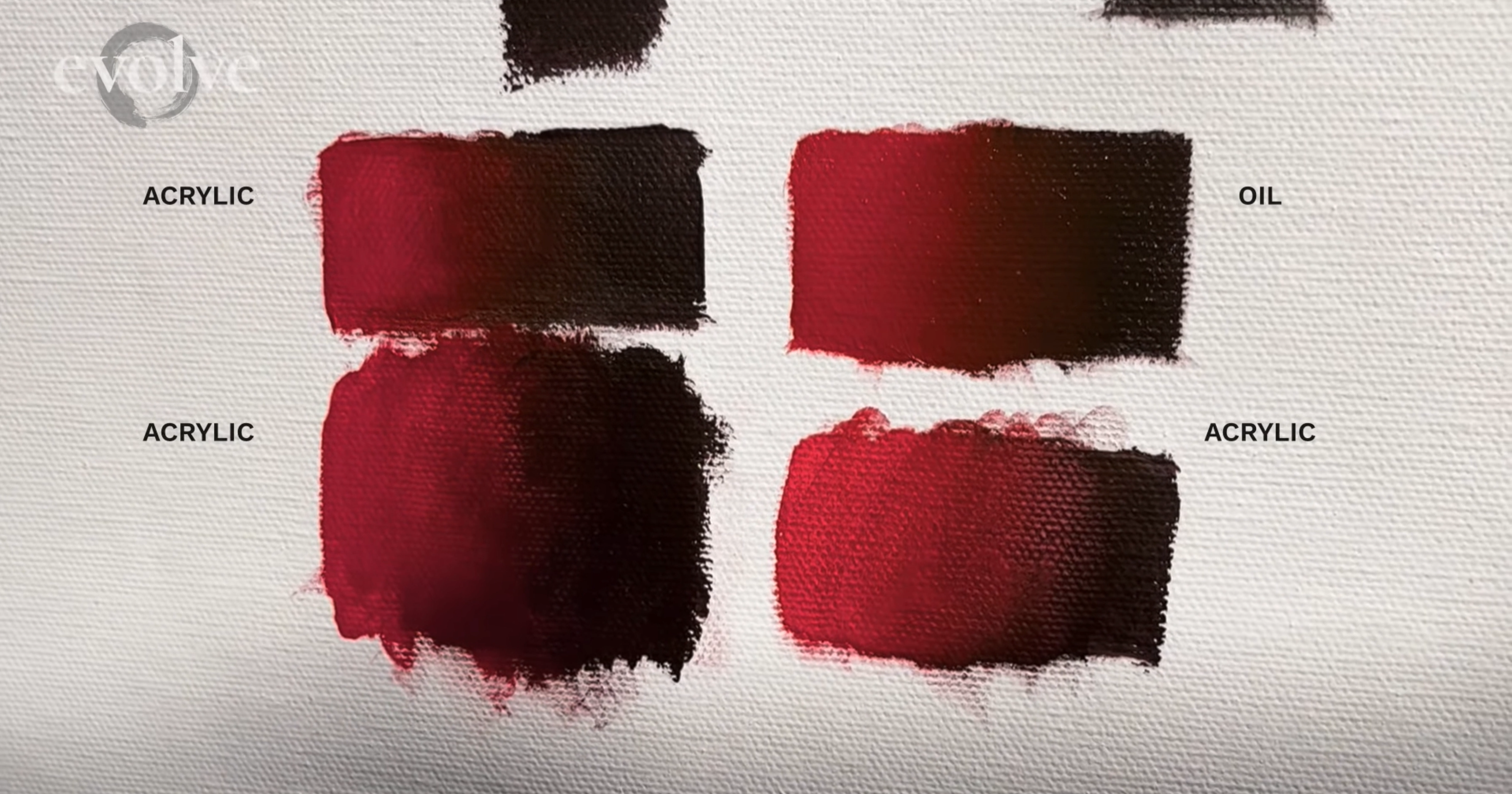
This side-by-side comparison of acrylic vs oil paint shows how much more soft a gradient can be made with oil paint.
I could not achieve the same softness with acrylic paint because the paint was drying so fast. When I added a small amount of water to my brush in the second and third gradients to keep the paint more malleable, the paint became too thin to blend smoothly without streaking. You can see how in the third gradient, when I put a gradient on top of a previously dry section, that dry layer underneath was peeking through.
With acrylic, the paint thins down as the gradients are being made, whereas with oil one layer would have covered directly on top of another. As it was being built up, it would get softer and softer.
Now, keep in mind that if I had allowed myself more tools or mediums to create these gradients, I would have been able to make a very soft gradient with acrylic, but with more tools at my disposal, imagine how much further I could have taken that gradient in oil.
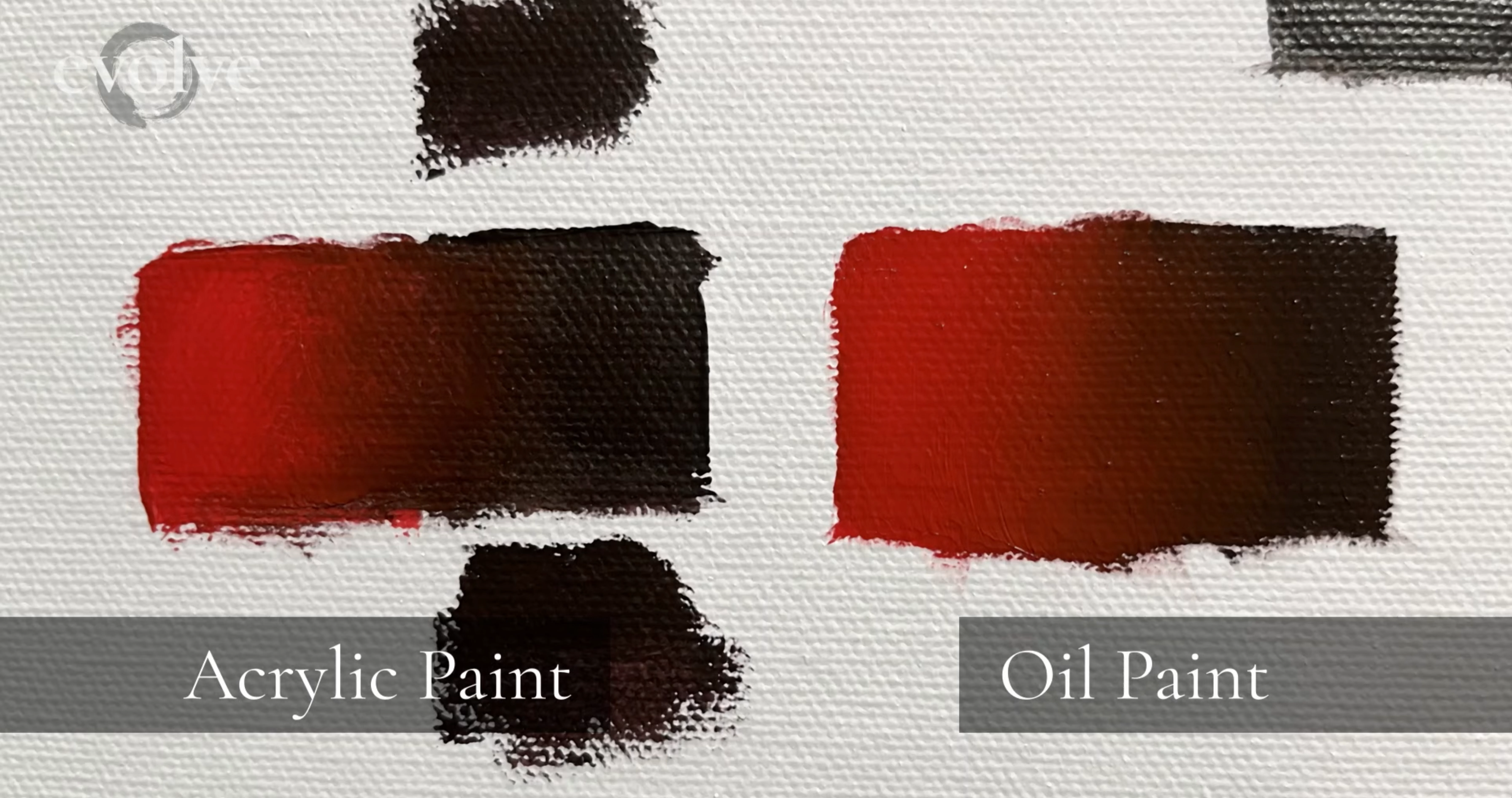
Acrylic vs oil paint: oil paint is far more superior in mixing paint on a canvas than acrylic.
So in this experiment of acrylic vs oil paint, the paint speaks louder than any tools, techniques, and even my own skill. As far as mixing paint on the palette goes, you shouldn’t have a problem with acrylic or oil as long as you are mixing with a palette knife. However, you can see how mixing with a brush in acrylic shows its weaknesses both on the canvas and on the palette.
Acrylic vs Oil Paint: Which Paint Gives More Control?
One of the themes that keeps repeating itself with acrylic vs oil paint is control. Oil paint simply gives you more control, flexibility, and freedom with your paint. This might seem intimidating at first, but as you can see from these gradients, oil paint, by default, is an easier, more forgiving paint to work with. With acrylic, however, you’re at the mercy of the paint controlling you, such as the fast drying time, forcing your hand or preventing you from finishing your gradients to the best of your ability. Except for the lightning-fast drying time, oil paint can essentially do everything that acrylic can do and then a whole lot more.
Acrylic vs Oil Paint T-Chart

These technical points explain why oil paint is the best to choose when you’re learning how to paint.
These are the main technical points for why oil paint is better than acrylic for learning painting.
Objection #1: Oil Paint is Expensive
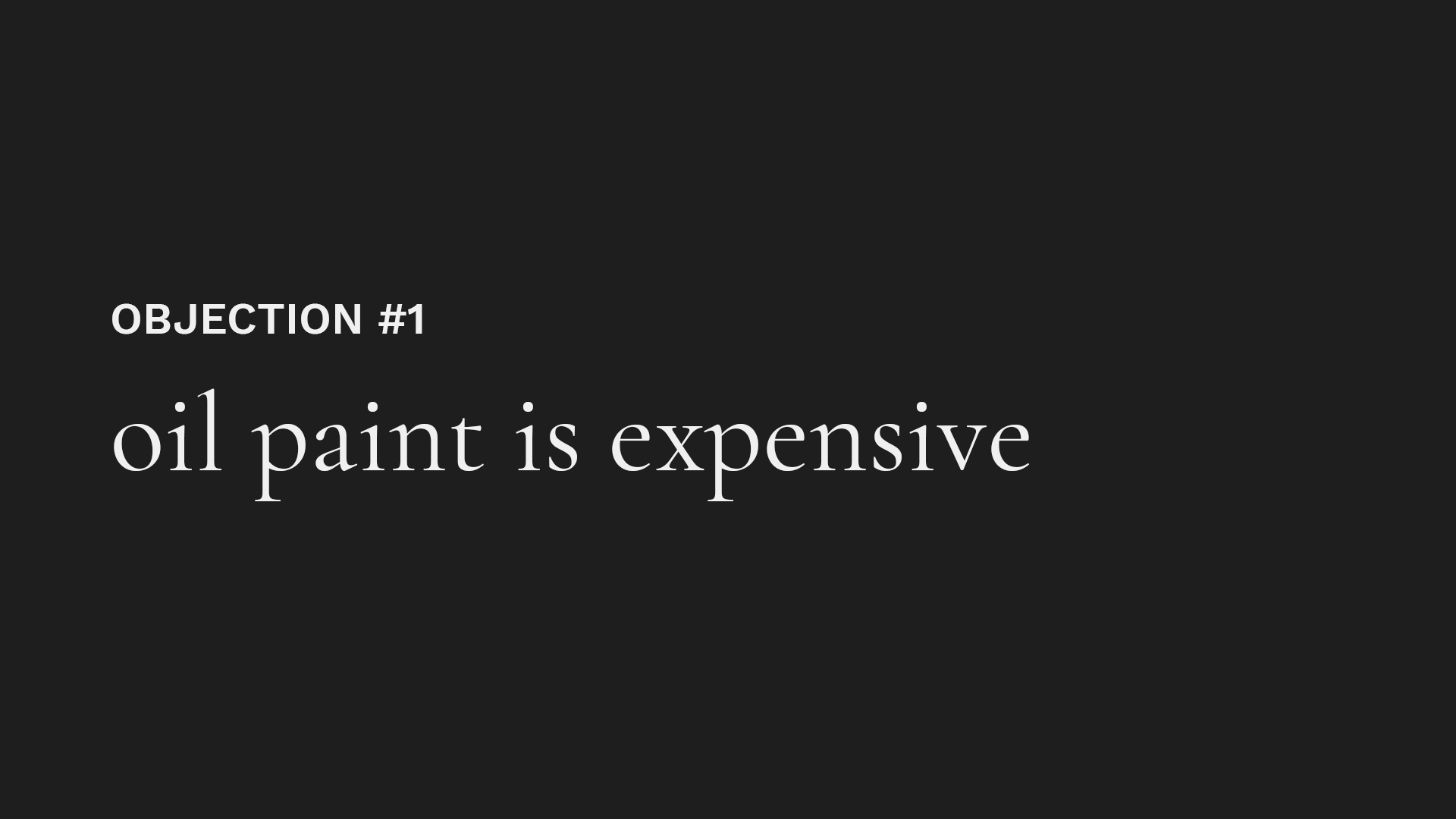
Many aspiring artists avoid oil paint because it is expensive, but it is worth the investment.
Now let’s address common objections and disadvantages in oil. The first one is that oil paint is expensive. This is perhaps the biggest objection to oil paint, and it’s a huge plus in favor of acrylic because it’s a significant barrier to entry. You can easily go out and buy a good quality set of acrylic paint, try it out, and see if you like painting without making any significant commitments with your time or money.
Oil paint, with its superior quality, luminous colors, and overall higher functionality, asks for a bit more commitment on the part of the artist. If you just want to dabble around and have fun, then, of course, paint with whatever you like. But if you want to be a serious hobbyist or an aspiring pro and you really want to get good at painting, then you should look at your education as an investment decision.

Cost-return analysis: acrylic vs oil paint. Though oil paint is more expensive than acrylic, it pays off in the shorter length of time it takes to gain pro art skills with oil paint vs acrylic.
When learning how to paint, the investment of money is higher for oil than acrylic, but the investment of time is significantly lower for oil than acrylic, so you get a much higher rate of return in a much shorter amount of time. If you can pay just a little more, you can figure that once you reach pro-level skills and you sell one of those paintings, you’ll have basically broken even on the difference between those materials.
Objection #2: Oil Paint Smells Bad/Toxic

Another objection is that oil paint gives off toxic fumes, however, toxic pigments and unhealthy popular solvents and fillers can be avoided by using good quality paint and substitute mediums.
The next objection is toxic fumes. I’ve heard a lot of people say that once you switch from acrylic to oil, you never go back. But I’ve actually encountered a few people who have tried oils and then gone back to acrylic because of the smell or toxicity of the paint.
There are, however, a few myths that need to be dispelled here. First, the vast majority of oil paint is not toxic. There are a few toxic pigments like lead, white, cadmium, and cobalt, which you can easily avoid with synthetic substitutes.
But what about the smell? The toxic fume smell associated with oils doesn’t come from the paint itself. It comes from these unhealthy popular solvents like turpentine and white spirits. Artists use these to thin down the paint and clean their brushes, but you can easily thin down your paint and clean your brushes with other alternatives, which is what I do and what I recommend. Find out how to clean oil paint brushes HERE.
Oil paint itself has a very faint smell, especially compared to acrylic. But that being said, I have encountered some cheap, poor-quality oil paint with lots of fillers, and personally, I thought that they smelled nasty, just gross. It makes me wonder how many people have tried oils and then were completely repulsed by it simply because they purchased poor quality paint, which I would not recommend to anyone.

These simple steps will help you to avoid toxic fumes and bad smells while oil painting.
Be mindful of what pigments you purchase. Use linseed oil to thin down your paint, use a bar of ivory soap to clean your brushes, and don’t buy poor-quality paint. Then, you shouldn’t have any problems at all with bad smells or toxic fumes.
Objection #3: Oil Paint is Intimidating
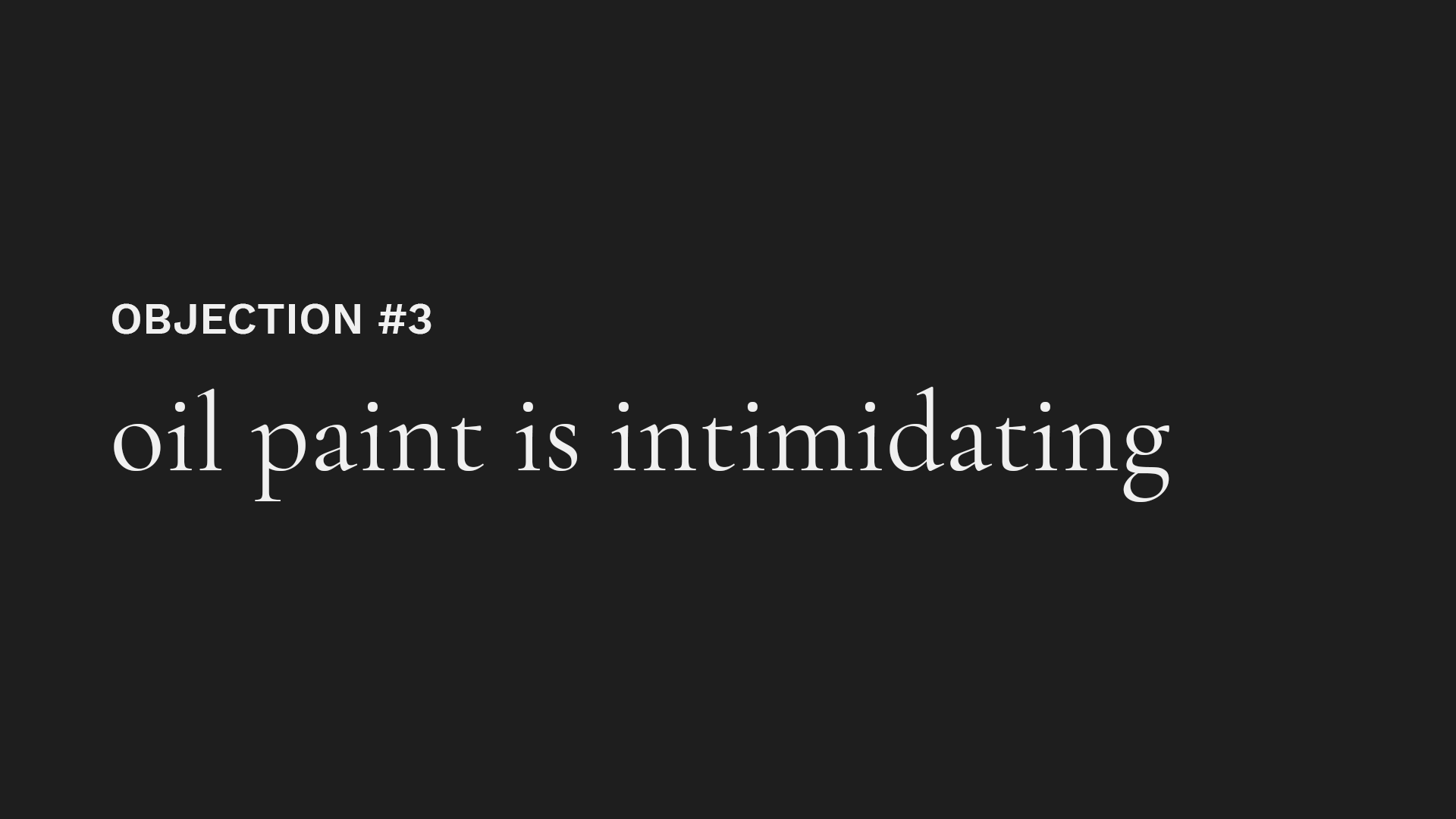
Beginner artists have a common misconception that oil paint is intimidating.
The last common objection is that oil paint is intimidating. Hopefully, by now I’ve shown you how learning with oil is easier than acrylic, that its value outweighs its cost, and that oil is not toxic or unhealthy. So if there’s anything left to address, it would be your own fears that you wouldn’t know what to do with the oil paint once you got it, that you would have this big contamination mess on your hands. And that’s a really big one.

It takes more than the right tools to progress in art. It also takes knowledge, experience and commitment.
Final Thoughts on Acrylic vs Oil Paints
So far we’ve only talked about the materials aspect of learning how to paint, but of course, there’s more involved regardless of what paint you use.
For an effective education, you need guidance and instructions that allow you to focus on one thing at a time and show you how to accomplish each new skill. You could have the best paint in the world, but without someone there to show you how to paint, the value is essentially meaningless.
You’re going to want to look for a guide, not just someone who gives you the information and then lets you fend for yourself. You want a guide who will commit to your results and help you every step of the way. When you have someone who is patient with you because they’ve made the same mistakes as you, and they’re there to hold your hand and guide you and keep you on track, there’s nothing left to fear.
Now, acrylic is great if you want to find out whether you like painting or not, but if you already know that you like painting and you want to get better at it, oil paint will help you learn more easily and more quickly, giving you the smoothest, most frictionless path to gaining a command over painting in general. And from that place of skill, you’ll be able to confidently branch out into other paints that interest you like acrylic, watercolor, or even digital.
Reaching Pro-level Art Skills
As I said, there’s a lot more that goes into making professional-quality paintings. I made a free mini-course talking about these three things that you absolutely must have in order to reach pro-level skills. Oil paint is not one of them. You can develop pro-level skills from just about any medium, but hopefully, I was able to provide a solid argument for why oil paint is the best of them to learn with.
Click HERE to watch the Three Things Mini Course to find out the 3 essentials needed to produce professional-level art every time you step in front of a canvas.
These three things run deeper, and if just one of them is missing, I don’t see how it’s possible to reach pro-level art skills in a reasonable amount of time. It’s a great road-mapping session for you. It’s about 15 minutes long but packed with powerful ideas. So, If you want to figure out your next steps in your development as an artist, you can access the 3 Things Course HERE.
I wish you all happy painting.
Taught by Daniel Folta of Evolve Artist.
FAQs
How did you conduct the gradient test?
ABSTRACT: The fastest method to learn painting involves the least amount of unnecessary resistance to acquire each skill. Painting gradients is one of the most essential but challenging skills every beginner must learn in order to reach pro level art skills. By analyzing the differences between gradients made by acrylic vs oil paint, we have found that oil paint blends more easily with the least amount of resistance compared to acrylic, thereby contributing to a more effective and efficient path to pro level art skills.
METHODOLOGY: The gradient test took every measure to reveal the characteristics of the paint and minimize the effects of tools, technique and skill, while maintaining equal conditions and process. Daniel Folta, artist and educator, was given the task of creating a gradient with specific parameters that would highlight any minor blemishes in the paint. This task required that each gradient be made with a semi-opaque red transitioning into an opaque black; in this way, the gradient would have to transition through multiple extremes, in value (light to dark), color (red to black), and edge (sharp or soft). Semi-opaque was chosen for the red as it is a common opacity for bright colors that painters will often have to make gradients with, while the more opaque black would assist in creating a smoother gradient. A filbert brush was chosen as the tool, as it is considered the best all-around brush and ideal for beginner artists. No other tools were allowed.
• High quality paint brands – M. Graham Acrylic Paint vs Old Holland Oil Paint
• Colors – Naphthol Red (semi-opaque acrylic) and Mars Black (opaque acrylic) vs Scheveningen Red (semi-opaque oil) and Mars Black (opaque oil)
• Brush – Simply Simmons Synthetic Filbert size 10
RESULTS: the gradient made by the oil paint was both easier to create and significantly softer than the gradient made by the acrylic. It was also easier to fix mistakes. To compensate for the fast drying time, Daniel attempted two more gradients, each with different approaches. The three gradients made in acrylic are as follows:
GRADIENT 1: Same process as gradient in oil (no medium added). This process was to lay down the black and then the red side by side, followed by a buffer shade as a mid-tone between the red and black. Once the buffer was laid in, each side of the buffer was gently and carefully softened with both criss-crossing brush strokes and gentle down-stroke taps. The acrylic paint dried too quickly on the canvas for the paint to blend smoothly.
GRADIENT 2: The brush was slightly wetted with water. Instead of a buffer, paint from the red was pushed into the black, while paint from the black was pushed into the red. The paint became too thin, and despite adding more paint, the brush began to pick up paint off the canvas.
GRADIENT 3: To confirm that the paint was getting thinner as it blended together (Acrylic Gradient 1 and Oil Gradient 1 both got thicker), the gradient was made on top of an already dry swath of acrylic. This gradient copied Gradient 2, except that the brushstrokes went up and down continuously on the canvas (as is shown by the majority of tutorials for blending acrylic).
All three gradients were halted short by the effects of the acrylic paint drying on the canvas.
CONSIDERATIONS
Had there been more tools, mediums, techniques, or different colors available, Daniel would have been able to create soft gradients in acrylic as well as oil.
Results may have differed in a larger sample size of artists participating in the test. A larger sample size would require that all participants closely follow the same process for each gradient.
Daniel Folta may have unknowingly avoided other factors that could have created resistance in making the gradient in oil.
Any thoughts or objections? Was this a good test? Let us know in the comments!
Acrylic vs Oil Paint: Which one should I purchase?
Acrylic paint is a great option if you want to find out if you like painting, or if you simply want to have fun creating something. It is also great for social painting events!
Oil paint is better for artists who want to learn how to paint and/or make pro level paintings. Except for the lightning fast drying time, oil paint can essentially do everything that acrylic can do, and has superior quality, luminous colors, and much higher functionality overall. If you really want pro level skills for making all kinds of art, then you should consider joining the Evolve Artist Program HERE.
How do you learn with oil paint?
We created a FREE mini course to get you started in oil painting. Sign up HERE to join our free mini course and learn how to paint in oils.

